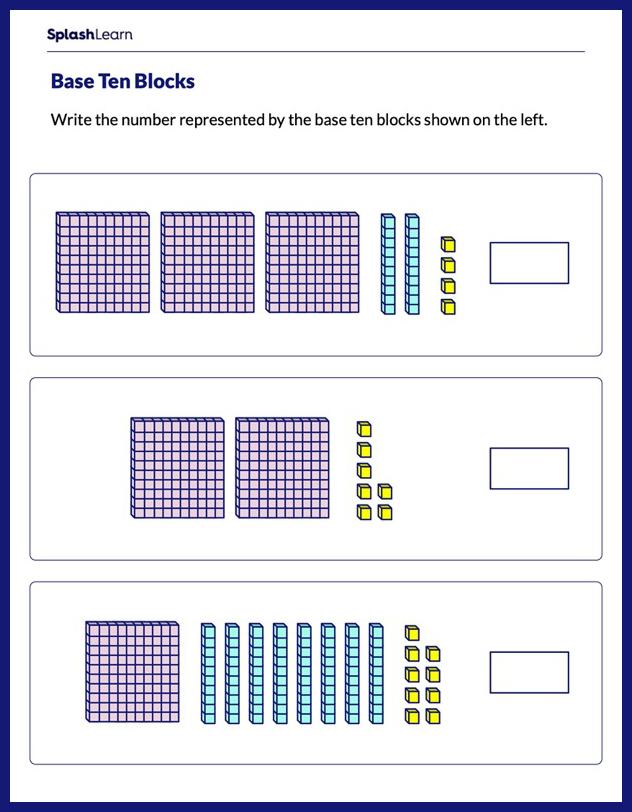What Is Base in Math?
The number system we use daily is the base-ten number system. It means that it uses ten different digits to represent numbers.
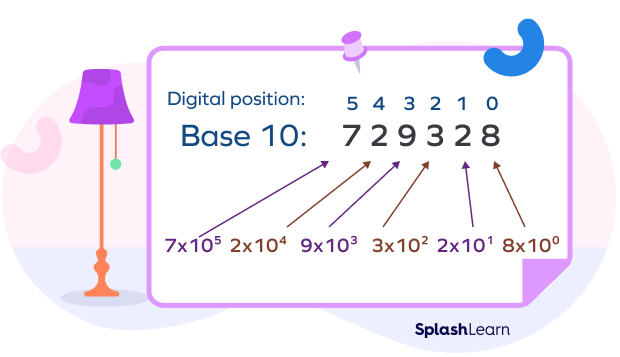
Base in math refers to the number of digits used to form the numbers. We have many number systems that use different bases.
Examples of base in math are as follows:
- The binary number system uses only 2 digits, that is, 0 and 1 to represent the numbers.
- The octal number system uses 8 digits, that is, 0 to 7, to represent the numbers.
- The most common number system that we use in our daily life is the decimal number system that uses the base 10, which uses digits from 0 to 9 for representing numbers.
- We also have a hexadecimal number system that uses 10 digits that is from 0 to 9 and 6 alphabets from A to F to represent the numbers in the number system.
Definition of a Base in Math
Base in math can be defined as the total number of digits or sometimes, the combination of digits and letters that is used to express numbers in a number system.
Another name for the base of a number system is “radix.” There are many number systems and each one of them has different bases. Numbers in a base start from 0.
Here are a few examples of base numbers in math and the number systems:
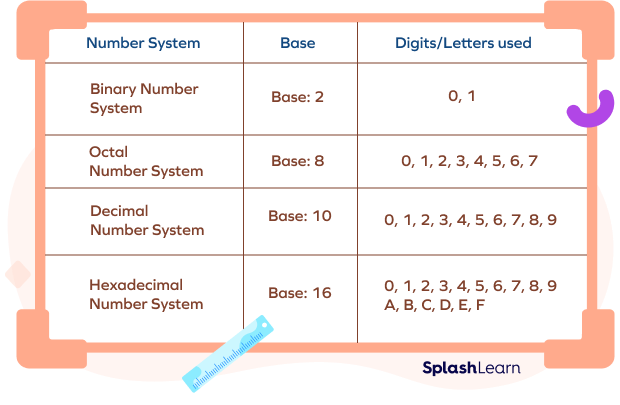
 Begin here
Begin here
How to Show the Base?
The base of any number is represented by adding a subscript to the number. It is written beside the given number in a smaller size.
To express a number in a particular base, we consider the following.
- The number
- The base
- The position of the number and the base
Decimal number 563 can be expressed as $563_{10}$.
$563_{10} = (5 \times 10^{2}) + (6 \times 10^{1}) + (3 \times 10^{0})$
Related Worksheets
Binary Number System (Base-2)
Base-2 number system or binary number system uses only 2 digits, 0 and 1. This system of base is popularly used in computers to store and process data. The digits 0 and 1 are called binary digits or BITS, in the abbreviated form. A subscript 2 is used to identify a base-2 number.
Let’s see how to convert bases in math. We will convert a binary number into its decimal form.
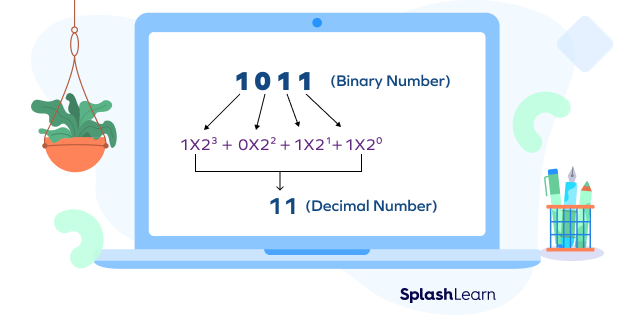
Let’s see another example.
$101_{2} = (1 \times 2^{0}) + (0 \times 2^{1}) + (1 \times 2^{2})$
$= 1 + 2 + 4$
$= 7$
Decimal Numbers and Their Corresponding Binary Equivalents
Now, we will see how to convert a decimal number to its corresponding binary number.
Example 1: Let’s find the corresponding binary number of the decimal number 10.
$\frac{10}{2} = 5,\; remainder\; = 0$
$\frac{5}{2} = 2,\; remainder\; = 1$
$\frac{2}{2} = 1,\; remainder\; = 0$
$\frac{1}{2} = 0,\; remainder\; = 1$
We divide the decimal number by 2 until we get 0 and keep track of the remainder, then we write the remainder from last to first, i.e., bottom to top as: 1010
Hence $10_{10} = 1010_{2}$
Example 2: We can also write this using the division method as follows.
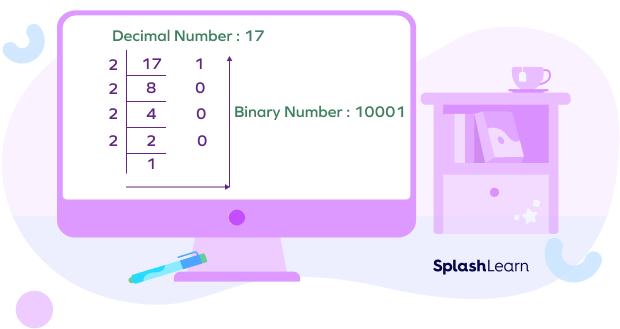
Let us look at a table to better understand the conversions:
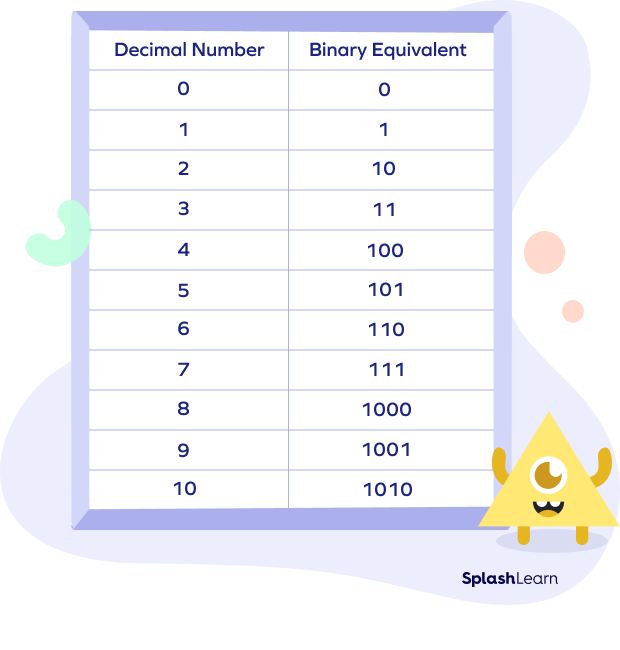
Octal Number System (Base-8)
Base-8 number system uses the 8 digits (0 to 7). The subscript 8 is used to represent a base-8 number. Let us take an example of a number in the octal number system, and convert into its decimal equivalent.
$401_{8} = (1 \times 8^{0}) + (0 \times 8^{1}) + (4 \times 8^{2})$
$= 1 + 0 + 256$
$=257$
Decimal Numbers and Their Corresponding Octal Equivalents
Now, we will see how to convert a decimal number to its corresponding octal number.
Example 1: Let us consider the decimal number 13. The corresponding octal number will be calculated as
$\frac{13}{8} = 1,\; remainder\; = 5$
$\frac{1}{8} = 0,\; remainder\; = 1$
We divide the decimal number by 8 until we get 0 and keep track of the remainder, then we write the remainder from last to first, i.e., bottom to top as: 15
Hence, the octal number 13 is equal to 15 in the octal number system.
Example 2: Let’s find the octal equivalent of the decimal number 100. Here, we follow the same method but represent the division in a tabular form.
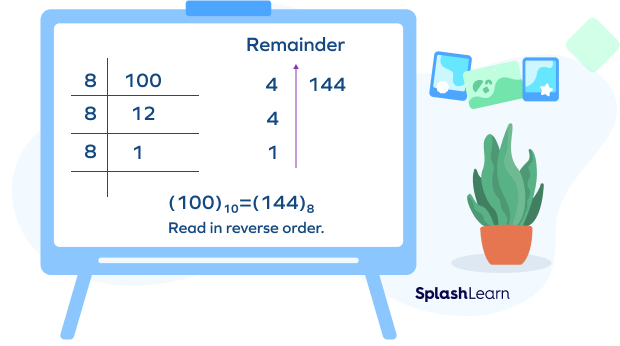
Let us look at a table to better understand the conversions:
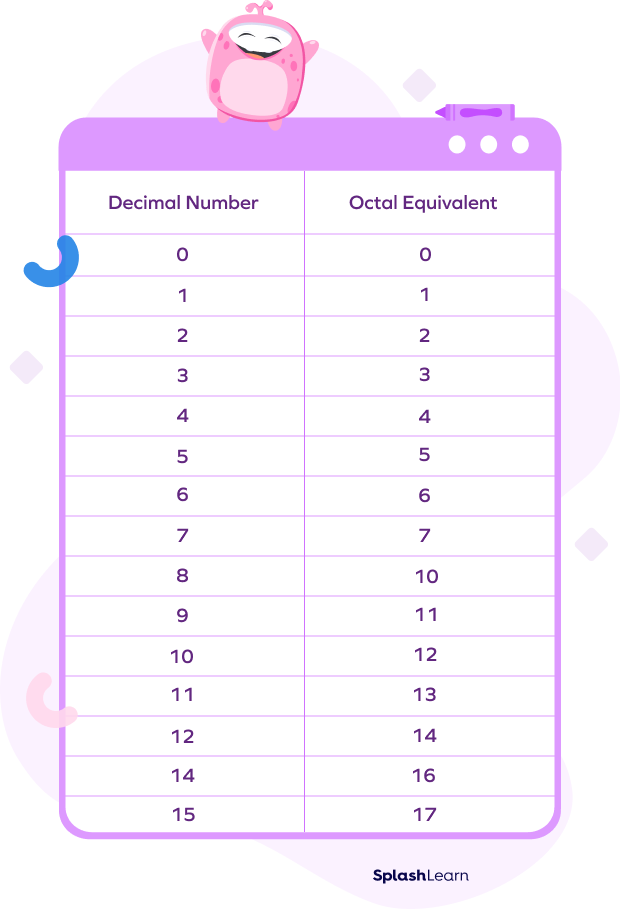
Decimal Number System (Base-10)
The base-10 number system uses the digits from 0 to 9. It is called base-10 or the decimal number system since there are only ten digits involved in representing any number. It is one of the most commonly used number systems around the world. We use this number system in our everyday life. Let us understand how we count in the base-10 number system. The subscript 10 is used to represent a base-10 number.
Let us take an example.
$743_{10} = (3 \times 10^{0}) + (4 \times 10^{1}) + (7 \times 10^{2})$. We often do not write 10 as the subscript to represent the decimal number system. So, if you see any number without any subscript written, you should understand that it is a base-10 number.
Numbers in Decimal Number System
The numbers in the decimal system follow a certain pattern as we observe the sets of ten numbers. If you place the digit 1 in the beginning of the first ten numbers, you get the set of the second ten numbers. Check it out. and so on.
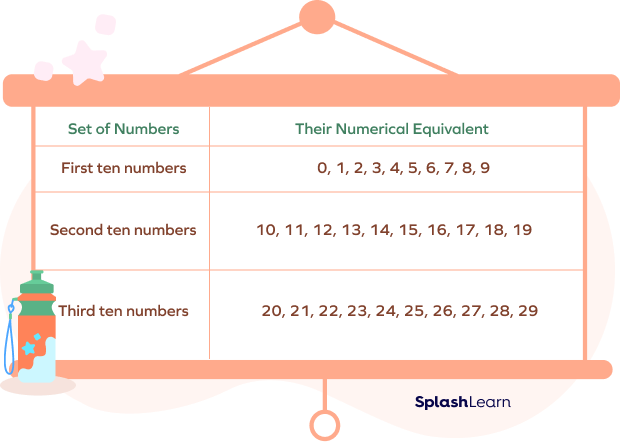
Hexadecimal Number System (Base-16)
The base-16 number system uses numbers as well as alphabets to represent numbers. Numbers from 0 to 9 and alphabets from A to F are used.
The 10 digits and 6 alphabets used are as follows:
$0,\; 1,\; 2,\; 3,\; 4,\; 5,\; 6,\; 7,\; 8,\; 9,\; A,\; B,\; C,\; D,\; E,\; F$
The base-16 system is commonly used in digital systems and computers for storage purposes.
Let us convert one hexadecimal number into the decimal number.
$3AE_{16} = (14 \times 16^{0}) + (10 \times 16^{1}) + (3 \times 16^{2})$
Decimal Numbers and Corresponding Hexadecimal Equivalents Chart
A hexadecimal number is represented as shown in the table given below. Each digit is multiplied by the power of 16 based on its position (the position starts from right to left) and the products are added.
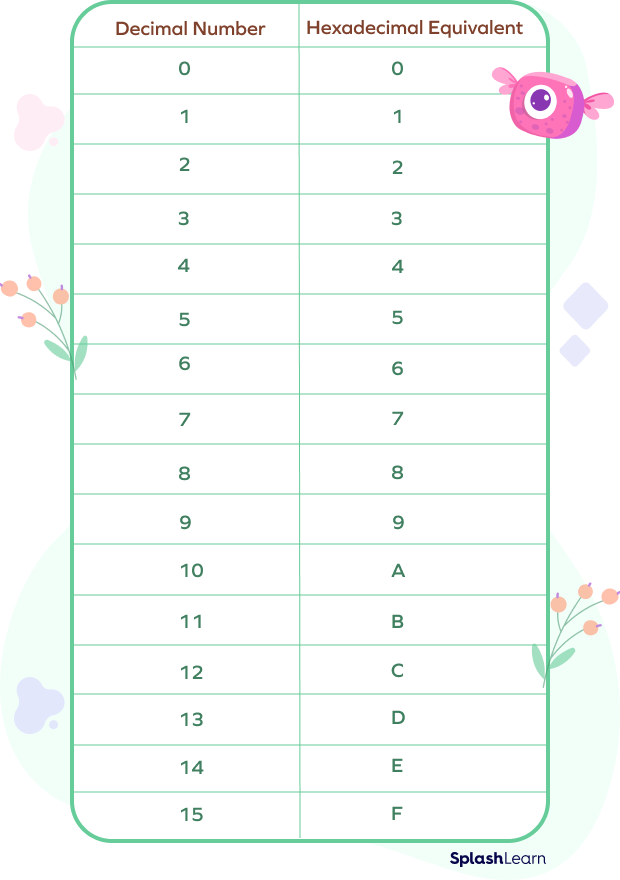
Let’s see how we can convert a decimal number into its hexadecimal equivalent.
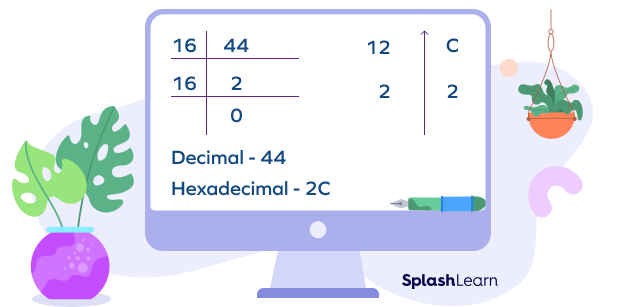
Examples of Other Number Systems and Their Bases
Now that we have learned about some commonly used base systems, let us see what other base systems there are:
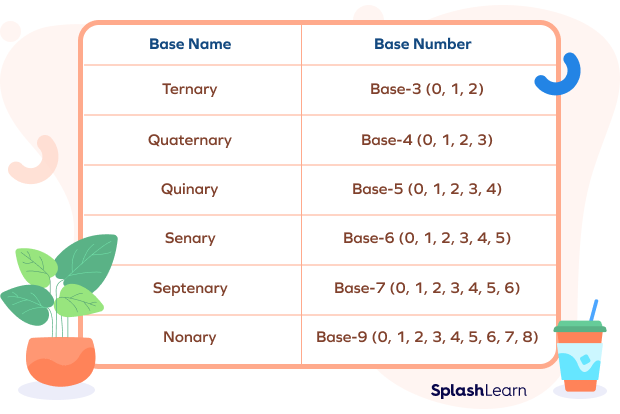
Conclusion
In this article, we learned about the base numbers, number systems, and how the base system in math works. Let’s solve a few examples and practice problems!
Facts about Base in Math
- The Number Base is also called the Radix. For example, for the decimal system the radix is ten.
- In Roman Numerals, 7 symbols are used to express their number system. Also, there is no symbol for 0!
Solved Examples on Base in Math
1. Convert the following base-10 numbers to their base-2 equivalents.
- 20
- 123
Solution:
- We know that to convert a base-10 number to a base-2 number, we have to divide it repeatedly by 2 until we get zero and then write the remainder from last to first.
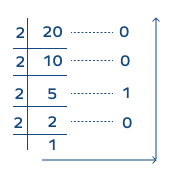
So, $20_{10} = 10100_{2}$
- Let’s find the binary equivalent of $123_{10}$.
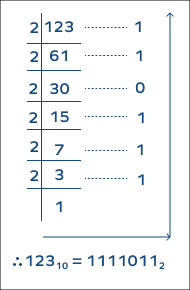
So, $123_{10} = 1111011_{2}$
2. Convert the hexadecimal number 7AB16 to base-10 decimal number.
Solution:
The following are steps to convert a hexadecimal number to a decimal number:
Step 1: Find the decimal equivalent of the hexadecimal alphabet from the table given.
Step 2: Multiply each digit with the power of 16 raised to its positional value taken from right to left. The right-most digit has positional value 0, the second most right has 1 and so on.
Step 3: Now add all the products.
$7AB_{16} = (11 \times 16^{0}) + (10 \times 16^{1}) + (7 \times 16^{2})$
$=11 + 160 + 1792$
$=1963_{10}$
Therefore, $7AB_{16} = 1963_{10}$
3. Convert $162_{8}$ from base-8 (octal), then to base-16 (hexadecimal) number system.
Solution:
To solve this, we will first convert the number from base-8 (octal number system) to base-10 (decimal number system) and then convert it from base-10 to base-16.
Step 1: Convert $163_{8}$ to base-10.
$162_{8} = (2 \times 8^{0}) + (6 \times 8^{1}) + (1 \times 8^{2})$
$= 2 + 48 + 64$
$= 114_{10}$
Step 2: Now, let us convert $114_{10}$ to base-16 (hexadecimal). We do this by dividing 114 repeatedly by 16 until we get a quotient lesser than 16. This is depicted below.
$\frac{114}{16}= 7,\; remainder\; = 2$
$\frac{7}{16} = 0,\; remainder\; = 7$
Now we take the remainders from last to first, i.e., 7 then 3
Therefore, $162_{8} = 72_{16}$
4. Add base-8 numbers $25_{8}$ and $32_{8}$ and give the result.
Solution:
First we convert both base-8 numbers to base-10 decimal number system
$25_{8} = (5 \times 8^{0}) + (2 \times 8^{1}) = 5 + 16 = 21_{10}$
Similarly,$ 32_{8} = (2 \times 8^{0}) + (3 \times 8^{1}) = 2 + 24 = 261_{0}$
Adding both base-10 numbers: $21 + 26 = 47$
Now, we convert $47_{10}$ to base-8 number
$\frac{47}{8} = 5,\; remainder\; = 7$
$\frac{7}{8} = 0,\; remainder\; = 7$
Hence the sum of the two octal numbers $25_{8}$ and $32_{8}$ is $77_{8}$.
5. Subtract base-8 numbers $25_{8}$ and $32_{8}$ and give the result.
Solution:
First we convert both base-8 numbers to base-10 decimal number system
$25_{8} = (5 \times 8^{0}) + (2 \times 8^{1}) = 5 + 16 = 21_{10}$
Similarly, $32_{8} = (2 \times 8^{0}) + (3 \times 8^{1}) = 2 + 24 = 26_{10}$
Subtracting both base-10 numbers we get $26 \;-\; 21 = 5$
In the octal number system, 5 is the same as 5 in the decimal number system. Hence, the difference between the two octal numbers $25_{8}$ and $32_{8}$ is $5_{8}$.
Practice Problems on Base in Math
Base in Math - Definition With Examples
What is the binary equivalent of 24?
To convert a decimal number to its equivalent binary, we divide the decimal number by 2 until we get 0 as a quotient and then write the remainder from the last to first, that is, from bottom to top. Therefore, $24_{10} = 11000_{2}$
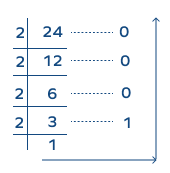
What is the decimal equivalent of the base-8 number $45_{8}$?
$45_{8} = (5 \times 8^{0}) + (4 \times 8^{1}) = 5 + 32 = 37_{10}$
Which of the following alphabet is not used in the hexadecimal number system?
The alphabet G is not used in the hexadecimal number system.
What is the value of the hexadecimal number $6BC_{16}$ in base-10 decimal number?
$6BC_{16} = (12 \times 16^{0}) + (11 \times 16^{1}) + (6 \times 16^{2})$
$= 12 + 176 + 1536$
$= 1724_{10}$
Therefore, $6BC_{16} = 1724_{10}$
What is the base of the ternary base system?
The base of the ternary base system is 3. It uses the digits 0, 1, and 2.
Frequently Asked Questions on Base in Math
What is a number system?
A set of digits or numbers that are used to express or write numbers is called a number system.
What is the most common number system in the world?
The decimal number system, or base-10 number system, is the most commonly used number system in the world.
What are natural numbers?
Positive whole numbers, excluding 0, i.e, 1, 2, 3, 4…, are called natural numbers.
What is the base of solids?
The bottom face of any solid is called its base.
What is the base of an exponent?
The base is a number that is raised to a certain power. It tells us what number is being multiplied. Example: In $5^{2}$, the number 5 is the base.














